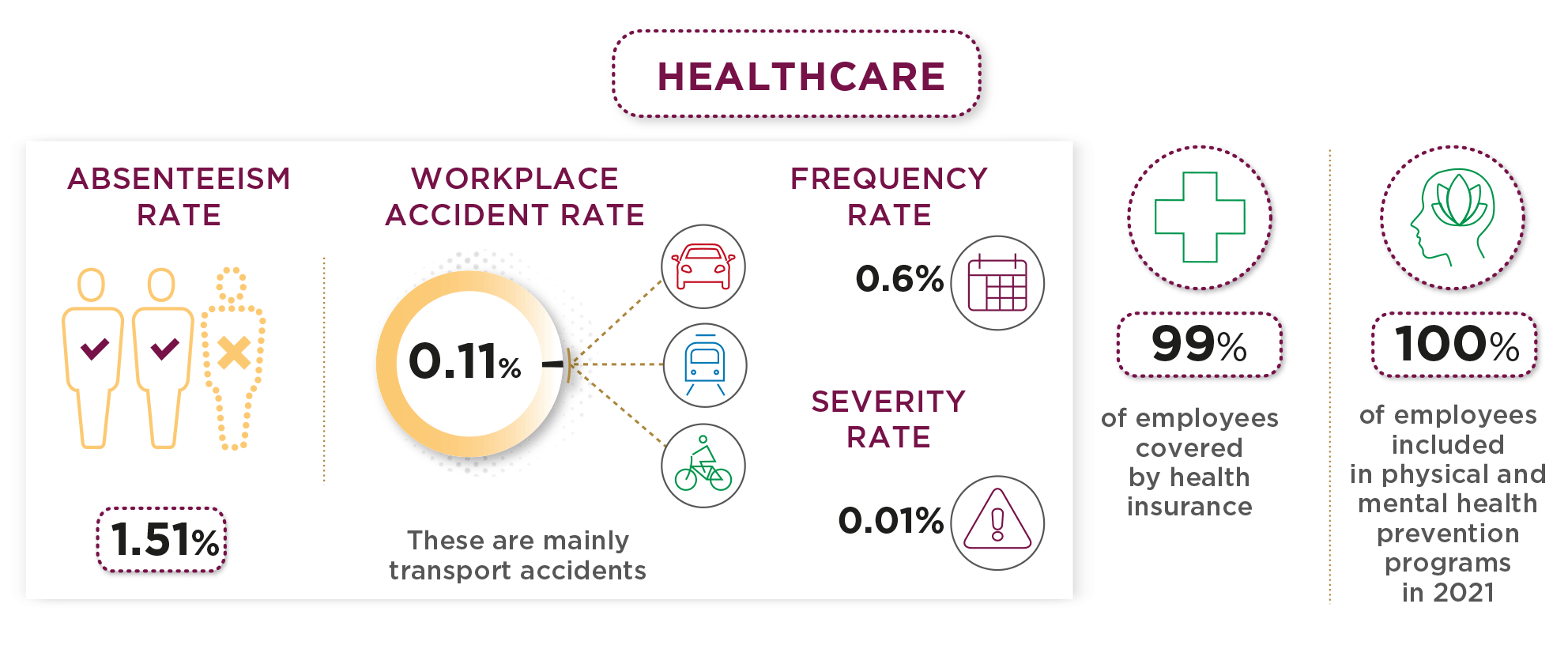4.1.3.4 Health insurance
99% of employees (full and part-time permanent and temporary contracts) are covered by medical coverage (social security or health insurance), irrespective of local social security provisions (government, government-company-employee or private company-employee contribution plans or self-funded). These programs cover serious or chronic illnesses to enable employees to be properly cared for, and to receive appropriate follow-up. In several of the Groupe’s regional markets, including the United States, Europe and India, employees can benefit from health insurance programs for themselves and their families.
The workplace accident rate(1) was 0.11. The main causes of workplace accidents were relate to transportation accidents (home-work commuting and work-related travel):
- the accident frequency (2) rate was 0.61;
- the severity rate(3) was 0.01.

HEALTHCARE
ABSENTEEISM RATE : 1.51%
WORKPLACE ACCIDENT RATE
These are mainly transport accidents : 0.11%
FREQUENCY RATE : 0.6%
SEVERITY RATE : 0.01%
99% of employees covered by health insurance
100% of employees included in physical and mental health prevention programs
in 2021.
4.1.3.5 Health and Safety
100% of the workforce in Groupe agencies are covered by these health and safety support plans. Most employees have sedentary jobs in offices, sitting in front of screens or working from home, and are seated behind screens. Agencies apply current local regulations on personal security in the workplace and are responsible for implementing their health support and action plans.
In the United States, federal law (Occupational Safety and Health Administration) may be supplemented by laws in each state, and possibly reinforced at the municipal level. In Europe, this mission is entrusted to dedicated local committees (Health and Safety Committee) and the CSE (Social and Economic Committee) in France. Elected or volunteer employees receive training on safety and first aid. Evacuation drills (fire, earthquake, etc.) are regularly conducted at the facilities, with support from general services safety teams (Re:Sources) and building managers. In all agencies, safety officers (fire or emergency evacuations) are trained each year; volunteers are trained in first aid. In India, Occupational Health and Safety regulations apply, and, as in many countries, small teams of employees are trained every year in all buildings and on all floors to assist others in the event of an emergency or evacuation. Given their large size, Publicis Sapient entities in India are ISO 45001 certified, thus covering 54% of the workforce of the Groupe in the country.
The “Monitoring Unit” set up for Covid-19 continued its support for country and regional departments to make specific arrangements for employees on a country-by-country basis and in conjunction with local management, such as working from home for all when necessary. The agencies remained open for employees with a need to come to the office (better working conditions, comfort and peace of mind, fight against isolation, etc.).
(1) Workplace accident rate: (Number of recordable workplace accidents/total workforce) x 100. 2021 coverage rate: 93%.
(2) Calculation of recordable workplace accident frequency rate: (Number of recordable workplace accidents/total number of hours worked) x1,000,000 (GRI 403-9 standard). 2021 coverage rate: 93%.
(3) Calculation of workplace accident severity rate: (Number of working days lost x 1,000) / Number of hours worked (GRI 403-9 standard). 2021 coverage rate: 93%.
